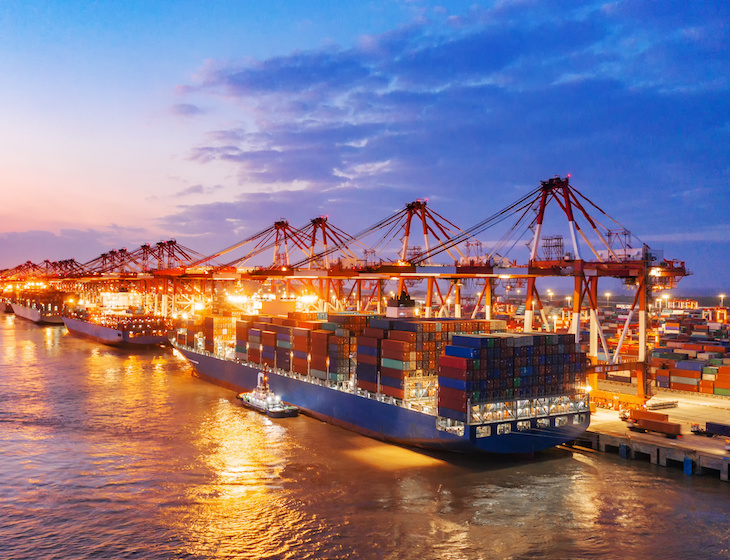
The growth of megaships has been seen as one of the main drivers of growth in the shipping industry and also the major driver for global alliances. Since it has become clear that large-scale vessels are here to stay, ports have had to face the new challenges and adapt. The question arises then, how have mega ships affected ports?
The rapid and dramatic growth in container ship sizes over the last decade has been well documented. As technology has advanced, we have seen the development of ULCVs (ULtra Large Container Vessels) as shipping lines compete to accommodate more cargo. ULCVs are defined as vessels with a length of up to 400m, a width of up to 59m, and a capacity of over 18,500 TEU (twenty foot equivalent units). The biggest ship currently stands at 23,000 TEU, but a 30,000 TEU mega ship is predicted to appear in the shipbuilding market in 2025.
The largest ships are deployed on the Asia-Europe trade route, not just because this is the lane that has sufficient cargo, but also because these lanes have ports that are better equipped to handle them. The number of ports unequipped to handle these mega ships significantly outnumbers those that currently can, which limits the number of ports carriers can call at.
Impact on ports
There is a direct correlation between the capacity of these increasingly large ships and the terminals or ports needed to handle these types of large vessels. There are size related fixes to existing infrastructure, such as bridge height, river width/depth, quay and wall strengthening, berth deepening and port equipment such as crane height and outreach. Mega ships also require expansion of infrastructure to cater to the higher peaks such as more physical yard and berth capacity.
What are the main barriers for mega ships to access ports?
- Ensuring water depth through dredging or locks
- Enhancing length and strength of quay walls
- Increasing crane and crane rail size
- Increasing yard space
- Improving container traffic, buffer capacity and onward routing
Ensuring water depth
Maritime access can be a challenge for many ports that are not deep-sea ports, such as estuary ports and river ports. Larger ships imply a larger need for dredging of the rivers or access channels leading to these ports. In addition to the maintenance dredging to keep channels at the same depth, larger ships also require deeper access that requires more intense dredging. Dredging and maintaining the access channel and fairway can be an effective solution for entering mega container ships albeit at a high cost.
Adapting quay walls
Limited berth size is another consideration for ports receiving megaships. In many ports, quay walls need to be heightened, strengthened and lengthened to have the capacity to accommodate the largest ships and the forces they exercise when they are berthing and moored. All of which limit ports that these vessels can call at.
Crane height and outreach
New larger and higher cranes or crane enlargement are other factors escalating the lack of port facilities. Mega ships pose challenges to cranes in terms of outreach width and height. In the past, if you wanted to increase loading or unloading productivity of a container vessel, it was not difficult to raise the loading speed by adding one or two gantry cranes. However nowadays, with the wide crane outreach and crane height for mega container ships, cranes can no longer be added.
Land-side operations
Big ship carriers often expect that terminals should be able to completely unload mega ships within a day. For example it is typical for 5,000 containers to be discharged over 1.5 days versus 5,000 containers discharged over 1 week historically. The increased demand on turnaround time has to be satisfied by ports. Mega container ships introduce new levels of congestion and activity and require more land for yard space for storage of unloaded containers, and more labor or higher port automation.
Improving onward routing
The arrival of mega-ships in ports will generate larger and more concentrated flows of containers in ports and their hinterland. If hinterland connection facilities cannot adapt with the growth of mega container ships, it gives rise to port congestion problems. For the shipping line, reliability of service is a very important, and port congestion is one of the factors which make the container line become unreliable.
The future
Future investments and innovations will certainly concentrate on terminal improvements. Some governments, in Europe and China, for example, have been more proactive in realising that their nation needs ports with facilities and have taken an active role in investing.
Arguably, one of the most successful ports in the world is Rotterdam where consideration has been given to where the market is going and investment has been made in order for the port to be prepared for those changes. The relationship between Rotterdam port and Rotterdam city has been managed very effectively and this is essential to create a sustainable port. Rotterdam Port is also well networked with other countries upstream.
‘Sustainability’ has taken its place alongside ‘digital’ in the shipping industry’s lexicon, and will no doubt become the driver of innovation for vessels and ports for the next decade or two. Initiatives required to enable ports to become more environmentally sustainable will also add to the investment costs for improving ports for future generations.
Conclusion
The rise of container megaships has been driven by the need for economies of scale for shipping lines. Mega-ships have mega-dimensions, which pose challenges to ports and require adaptations and infrastructure investments. Large capital investment is required to make the changes to ports required – such as creating wider and deeper channels for ships coming into ports and extending turning lanes to make them long enough to turn ships around. As well as providing larger container storage areas and more and bigger ship-to-shore cranes.


